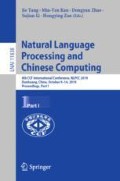Abstract
Topic and emotion are two essential elements in poetry creation, and also have critical impact on the quality of poetry. Inspired by this motivation, we propose a novel model to inject rich topics and emotions into modern Chinese poetry generation simultaneously in this paper. For this purpose, our model leverages three novel mechanisms including (1) learning specific emotion embeddings and incorporate them into decoding process; (2) mining latent topics and encode them via a joint attention mechanism; and (3) enhancing content diversity by encouraging coverage scores in beam search process. Experimental results show that our proposed model can not only generate poems with rich topics and emotions, but can also improve the poeticness of generated poems significantly.
Access this chapter
Tax calculation will be finalised at checkout
Purchases are for personal use only
References
Bahdanau, D., Cho, K., Bengio, Y.: Neural machine translation by jointly learning to align and translate. CoRR abs/1409.0473 (2014), version 7
Bui, Q.V., Sayadi, K., Amor, S.B., Bui, M.: Combining latent dirichlet allocation and K-means for documents clustering: effect of probabilistic based distance measures. In: Nguyen, N.T., Tojo, S., Nguyen, L.M., Trawiński, B. (eds.) ACIIDS 2017. LNCS (LNAI), vol. 10191, pp. 248–257. Springer, Cham (2017). https://doi.org/10.1007/978-3-319-54472-4_24
Cheng, W.F., Wu, C.C., Song, R., Fu, J., Xie, X., Nie, J.Y.: Image inspired poetry generation in xiaoice. CoRR abs/1808.03090 (2018). version 1
Ghazvininejad, M., Shi, X., Priyadarshi, J., Knight, K.: Hafez: an interactive poetry generation system. In: Proceedings of ACL 2017, System Demonstrations, pp. 43–48. Association for Computational Linguistics (2017)
He, J., Zhou, M., Jiang, L.: Generating Chinese classical poems with statistical machine translation models. In: Proceedings of the Twenty-Sixth AAAI Conference on Artificial Intelligence, AAAI 2012, pp. 1650–1656. AAAI Press (2012)
Hochreiter, S., Schmidhuber, J.: Long short-term memory. Neural Comput. 9(8), 1735–1780 (1997)
Hu, T., et al.: Touch your heart: A tone-aware chatbot for customer care on social media. CoRR abs/1803.02952 (2018), version 2
Joulin, A., Grave, E., Bojanowski, P., Mikolov, T.: Bag of tricks for efficient text classification. In: Proceedings of the 15th Conference of the European Chapter of the Association for Computational Linguistics: Volume 2, Short Papers, pp. 427–431. Association for Computational Linguistics, April 2017
Kingma, D.P., Ba, J.: Adam: a method for stochastic optimization. CoRR abs/1412.6980 (2014). version 1
Li, J., Galley, M., Brockett, C., Gao, J., Dolan, B.: A persona-based neural conversation model. CoRR abs/1603.06155 (2016)
Li, Y., Xiao, T., Li, Y., Wang, Q., Xu, C., Zhu, J.: A simple and effective approach to coverage-aware neural machine translation. In: Proceedings of the 56th Annual Meeting of the Association for Computational Linguistics (Volume 2: Short Papers), pp. 292–297. Association for Computational Linguistics (2018)
Liu, B.: Sentiment Analysis and Opinion Mining. Synthesis Lectures on Human Language Technologies. Morgan & Claypool Publishers, San Rafael (2012)
Manurung, R., Ritchie, G., Thompson, H.: Using genetic algorithms to create meaningful poetic text. J. Exp. Theor. Artif. Intell. 24(1), 43–64 (2012)
Mihalcea, R., Tarau, P.: Textrank: bringing order into text. In: Proceedings of the 2004 Conference on Empirical Methods in Natural Language Processing (2004)
Mikolov, T., Chen, K., Corrado, G., Dean, J.: Efficient estimation of word representations in vector space. CoRR abs/1301.3781 (2013). Version 3
Oliveira, H.G.: Poetryme: a versatile platform for poetry generation. Comput. Creativity, Concept Invention Gen. Intell. 1, 21 (2012)
Sutskever, I., Vinyals, O., Le, Q.V.: Sequence to sequence learning with neural networks. In: Advances in Neural Information Processing Systems, pp. 3104–3112 (2014)
Tu, Z., Lu, Z., Liu, Y., Liu, X., Li, H.: Modeling coverage for neural machine translation. In: Proceedings of the 54th Annual Meeting of the Association for Computational Linguistics (Volume 1: Long Papers), pp. 76–85. Association for Computational Linguistics (2016)
Wang, Z., et al.: Chinese poetry generation with planning based neural network. In: Proceedings of COLING 2016, the 26th International Conference on Computational Linguistics: Technical Papers, pp. 1051–1060. The COLING 2016 Organizing Committee (2016)
Wu, Y., et al.: Google’s neural machine translation system: bridging the gap between human and machine translation. CoRR abs/1609.08144 (2016). Version2
Xing, C., et al.: Topic augmented neural response generation with a joint attention mechanism. CoRR abs/1606.08340 (2016)
Xu, L., Lin, H., Pan, Y., Ren, H., Chen, J.: Constructing the affective lexicon ontology. J. China Soc. Sci. Tech. Inform. 2, 006 (2008)
Yang, C., Sun, M., Yi, X., Li, W.: Stylistic Chinese poetry generation via unsupervised style disentanglement. In: Proceedings of the 2018 Conference on Empirical Methods in Natural Language Processing, pp. 3960–3969 (2018)
Yuan, J., et al.: LightLDA: big topic models on modest computer clusters. In: Proceedings of the 24th International Conference on World Wide Web, pp. 1351–1361. International World Wide Web Conferences Steering Committee (2015)
Zhang, X., Lapata, M.: Chinese poetry generation with recurrent neural networks. In: Proceedings of the 2014 Conference on Empirical Methods in Natural Language Processing (EMNLP), pp. 670–680. Association for Computational Linguistics, Doha, Qatar, October 2014
Zhou, H., Huang, M., Zhang, T., Zhu, X., Liu, B.: Emotional chatting machine: emotional conversation generation with internal and external memory. In: Proceedings of the Thirty-Second AAAI Conference on Artificial Intelligence, (AAAI 2018), pp. 730–739 (2018)
Author information
Authors and Affiliations
Corresponding author
Editor information
Editors and Affiliations
Rights and permissions
Copyright information
© 2019 Springer Nature Switzerland AG
About this paper
Cite this paper
Guo, X., Chen, M., Song, Y., He, X., Zhou, B. (2019). Automated Thematic and Emotional Modern Chinese Poetry Composition. In: Tang, J., Kan, MY., Zhao, D., Li, S., Zan, H. (eds) Natural Language Processing and Chinese Computing. NLPCC 2019. Lecture Notes in Computer Science(), vol 11838. Springer, Cham. https://doi.org/10.1007/978-3-030-32233-5_34
Download citation
DOI: https://doi.org/10.1007/978-3-030-32233-5_34
Published:
Publisher Name: Springer, Cham
Print ISBN: 978-3-030-32232-8
Online ISBN: 978-3-030-32233-5
eBook Packages: Computer ScienceComputer Science (R0)


